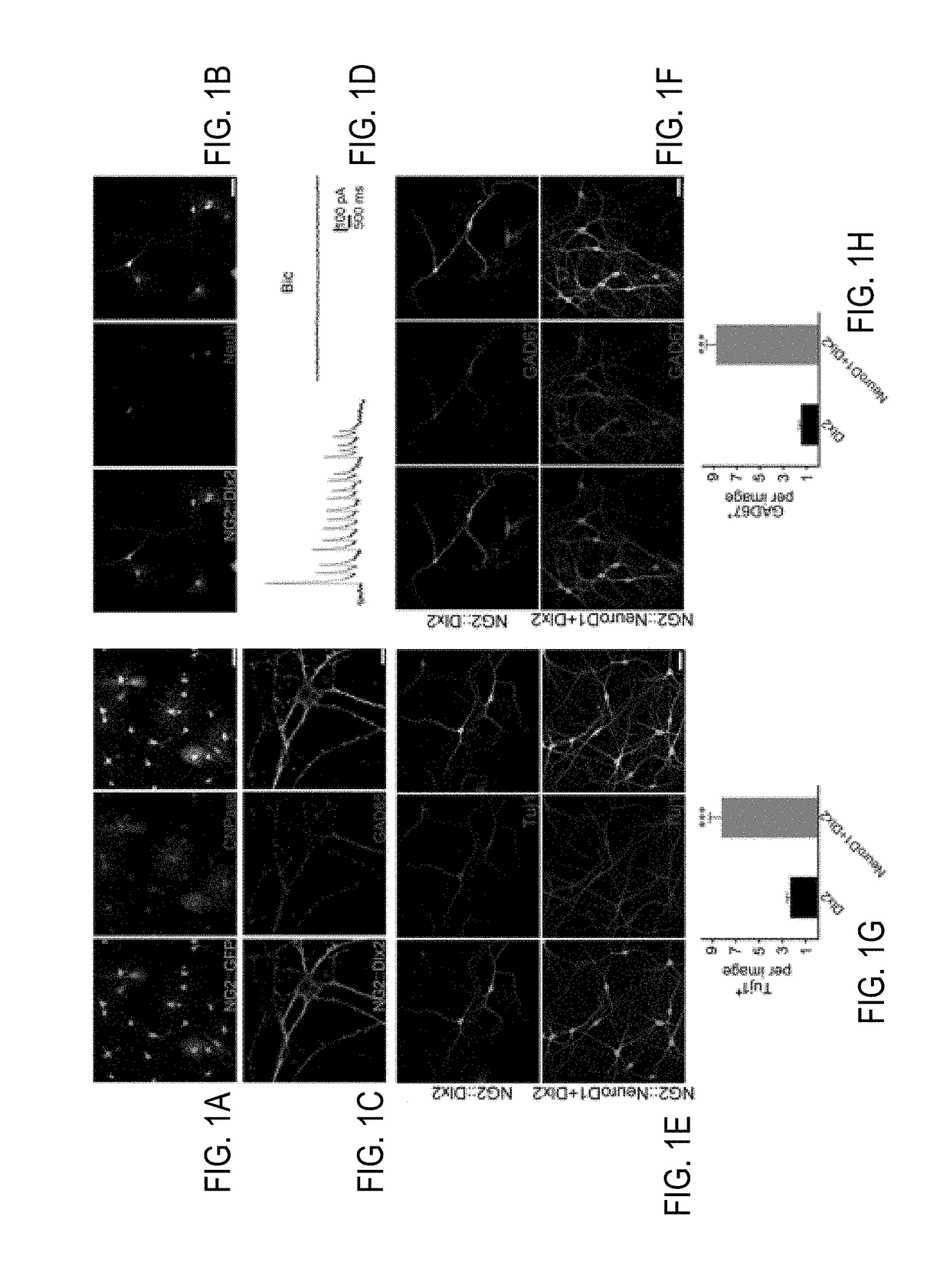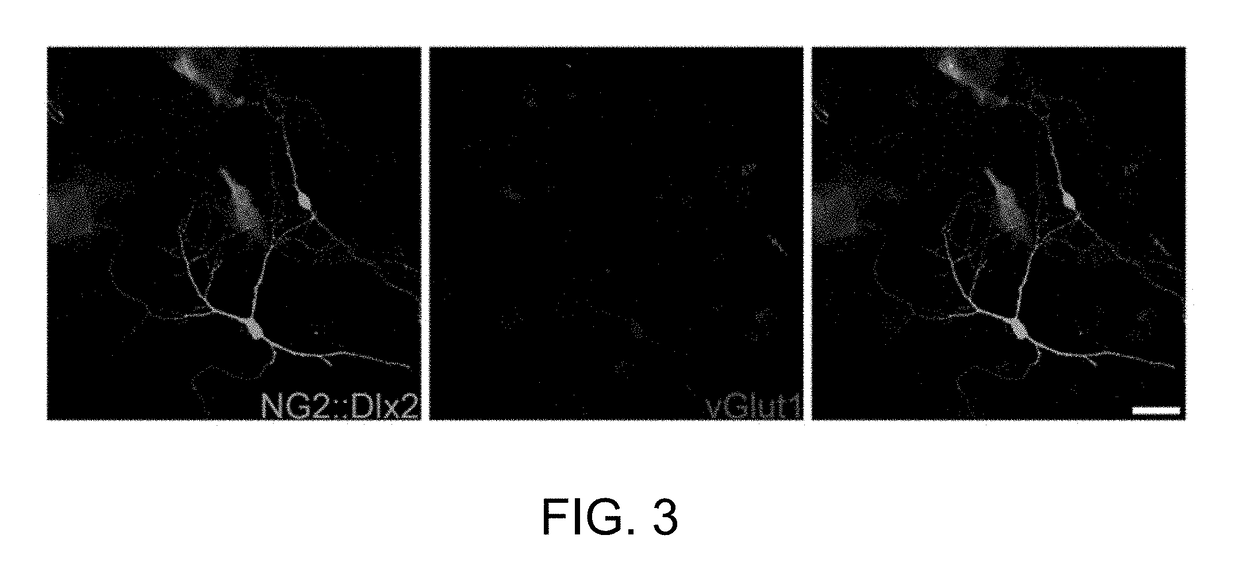GENERATING GABAergic NEURONS IN BRAINS
a technology of gabaergic neurons and brains, which is applied in the direction of peptides/proteins, drug compositions, peptides, etc., can solve the problem of no effective treatment for huntington's diseas
- Summary
- Abstract
- Description
- Claims
- Application Information
AI Technical Summary
Benefits of technology
Problems solved by technology
Method used
Image
Examples
example 1
eprogramming Glial Cells into GABAergic Neurons in the Striatum to Treat Huntington's Disease
NG2 Cell Culture
[0053]As described elsewhere (Guo et al., Cell Stem Cell, 14:188-202 (2014)), mouse cortical tissue was dissected out and isolated from the brain of postnatal pups (P3-P5). Cortical cells were dissociated (0.25% trypsin-EDTA) and plated in 25 cm2 flasks coated with poly-D-lysine (PDL, Sigma), and cultured in DMEM / F12 (GIBCO) with 10% fetal bovine serum (FBS, GIBCO) for 9 days, with the medium changed once every 3 days. On the ninth day, the flasks were rigorously shook, and the supernatant was collected and centrifuged to harvest NG2 cells with a small number of neurons, astrocytes, and microglial cells. The majority of astrocytes were flat and not easy to shake off the flasks. After centrifuge, cells were resuspended and seeded on PDL-coated coverslips (12 mm). The NG2 cells were maintained in serum-free DMEM medium (GIBCO) supplied with N2 supplements (STEMCELL), 10 ng / mL p...
example 2
ing Medium Spiny Neurons to Treat Huntington's Disease
[0076]A Huntington's disease (HD) mouse model, R6 / 2 transgenic mice, which carries 120 CAG repeats from human HD gene and exhibit disease onset at about 8-12 weeks of age is obtained. NeuroD1+Dlx2 AAV is injected into these HD mice at age of 6, 8, 10, and 12 weeks old to confirm that the in vivo reprogramming technology described herein extends the life of HD mice and improves the function of these HD mice. Injecting NeuroD1 and Dlx2 into the striatum of HD mice can have the ability to regenerate functional GABAergic neurons including medium spiny neurons, which in turn can increase the life span and rescue at least some of the functional deficits of HD mice.
example 3
onversion of Glial Cells into GABAergic Neurons Inside Brains
[0077]AAV5 viral vectors were produced to express NeuroD1 and Dlx2. The AAV5 expressing NeuroD1 and Dlx2 viral vectors were injected into R6 / 2 mice, a mouse model for Huntington's disease. Following injection of AAV5 expressing NeuroD1 and Dlx2, astrocytes of the striatum generated new neurons in the Huntington's disease model R6 / 2 mice (FIGS. 14A-F). Most of the NeuroD1+Dlx2 converted neurons were GABAergic neurons (FIGS. 15A-B).
[0078]In addition to AAV5 viral vectors, the capability of AAV9 viral vectors for in vivo cell conversion was confirmed. An AAV9 viral vector was used to express NeuroD1 and Dlx2 in astrocytes under the control of astrocyte promoter GFAP. The AAV9 viral vectors expressing NeuroD1 and Dlx2 were able to convert astrocytes into neurons (FIG. 16A-D). Furthermore, immunostaining with a GABAergic neuron marker (GAD67) demonstrated that the majority of NeuroD1 / Dlx2-converted neurons were GABAergic neuron...
PUM
| Property | Measurement | Unit |
|---|---|---|
| frequency | aaaaa | aaaaa |
| volume | aaaaa | aaaaa |
| pH | aaaaa | aaaaa |
Abstract
Description
Claims
Application Information
 Login to View More
Login to View More - R&D
- Intellectual Property
- Life Sciences
- Materials
- Tech Scout
- Unparalleled Data Quality
- Higher Quality Content
- 60% Fewer Hallucinations
Browse by: Latest US Patents, China's latest patents, Technical Efficacy Thesaurus, Application Domain, Technology Topic, Popular Technical Reports.
© 2025 PatSnap. All rights reserved.Legal|Privacy policy|Modern Slavery Act Transparency Statement|Sitemap|About US| Contact US: help@patsnap.com



